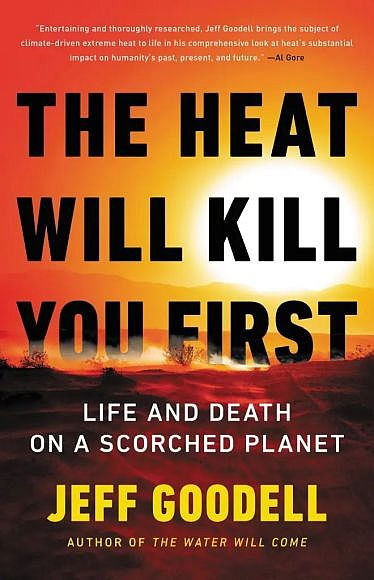

| THE HEAT WILL KILL YOU FIRST Life and Death on a Scorched Planet Jeff Goodell Little, Brown and Company (July 11, 2023) |
Rating: 5.0 High |
|||
| ISBN-13 978-0316497572 | ||||
| ISBN-10 0316497576 | 385pp. | HC/BWI | $29.00 | |
It is said that James Hansen counted on the day of his congressional testimony about climate change, 23 June 1988, being unusually hot. So it was, and it helped him drive his point home. His point was that science finally had solid evidence to confirm what theory had long predicted: Earth was warming due to human actions releasing CO2, and at some point the warming would become dangerous if it continued.
Thirty-five years later, the summer we are experiencing now, with high-temperature records falling like ninepins across the globe, confirms the danger.1 Some data points:
It would be hard for Jeff Goodell to claim equally good timing for the release of the book he has worked on for four years: its 11 July release date depended on the work schedules of many people. But it is certainly well-timed in relation to the ongoing warming of the globe and the effects of its warming. He summarizes those effects here:
"The heat we are pumping into the sky is the prime mover of the climate crisis. The climate impacts you hear about most often, from sea-level rise to droughts to wildfires, are all second-order effects of a hotter planet. The first-order effect is heat. It is the engine of planetary chaos, the invisible force that melts the ice sheets that will flood coastal cities around the world. It dries out the soil and sucks the moisture out of trees until they are ready to ignite. It revs up the bugs that eat the crops and thaws the permafrost that contains bacteria from the last ice age. When the next pandemic hits, the chances are good it will be caused by a pathogen that leapt from an animal that was seeking a cooler place to live." – Page 15 |
 |
Phoenix, Arizona is the queen city of The Valley of the Sun. Its metropolitan area includes Maricopa and Pinal Counties. Since 2012, the population of these counties has grown from 4.2 million to more than 5 million. Phoenix is now the tenth largest metro area in the country, and is expected to keep growing through 2050.
The license plate shown above was issued for Arizona's centennial of statehood in 2012. It celebrates the dry, hot climate of the region known as the Sun Belt, and more specifically as the tourist mecca "Valley of the Sun" — touted as "a mosaic of boundless indoor and outdoor adventure." 8
Much has changed in the decade since. With its water supply subject to overuse, its air travel subject to flight cancellations due to heated air, and its population subject to heat injury or death, Phoenix has become a model for the risks of climate change. But local governments are taking action against these threats. Like the mythical bird that arose from its own ashes, Phoenix may well become a model solution for those threats.9
The central premise of the book is one long understood by medical science. Put simply, it is that the human body has a limited range of temperatures in which it can operate without damage. The limits of that range depend on a host of conditions: clothed or unclothed; humid or arid; actively working or quiet; young or old; healthy or unhealthy. But a good rule of thumb is that the safe range is between 40° and 95° F (4.4° and 35° C).3 Outside this range, there is a risk of hypothermia (freezing) or hyperthermia (boiling). Since the world is generally warming, the latter is of most concern.4 Jeff Goodell illustrates this with the tale of Jonathan Gerrish and Ellen Chung, both young and healthy, who died on a day hike near their home in the foothills of the Sierra Nevada — simply because of heat.
It is even worse for those who have to work outdoors on sweltering summer days, like migrant farm workers, or those who must live in urban heat islands like the Ramapuram neighborhood of Chennai in southern India. But people in the United States face both conditions. The city of Phoenix, Arizona lies in The Valley of the Sun, and is currently enduring a record-breaking stretch of temperatures above 110° F (43.3° C.) For the homeless on the city's sun-drenched streets, it is no picnic. In 2021, 339 people died of heat in Phoenix's Maricopa County: more than three times the toll of a decade earlier (page 66.)
Migrant workers are at greater risk. They frequently are expected to work long hours without enough cool water to drink and without rest breaks. That was the fate of Sebastian Perez, an undocumented immigrant from Guatemala hoping to earn enough to buy a house back home where he and his wife Maria would raise a family. He joined his uncle at a nursery in Oregon's Willamette Valley. On 26 June 2021, as the temperature hit 106° F, he kept working. It was the last day he would ever work.5
In addition to sudden death due to heat stroke, there is a risk of chronic kidney disease for those who regularly work outdoors in hot weather. Twenty thousand farmworkers have died of it in the sugarcane fields of Costa Rica and El Salvador since 2002. Thousands more have been forced into dialysis — an expensive and unpleasant remedy. This disease too affects workers around the world — including those in Florida and California. A New England Journal of Medicine editorial6 warns that chronic kidney disease is likely to be just one of many heat-sensitive illnesses that will be unmasked and accelerated by climate change. In addition, extreme heat impairs thinking; workers become clumsy, make more mistakes, suffer more accidents.7
In sum, heat is a silent stealer of worker productivity and often an insidious assassin of American workers. And yet little is done to provide the relatively low-cost relief measures that would prevent most of these losses: regular work breaks in shaded places; cool water to drink; educating workers on the effects of heat. There are no federal rules for working outdoors in high heat, and as of 2021 only two states — California and Washington — have rules to protect workers from heat illnesses.
As Jeff Goodell explains in this book, there is a great deal more to consider about the transformation we are bringing upon the world: rising seas, lower crop yields, diseases and pests spreading north and south; shortages of clean fresh water; increasing climate migration; probable extinction of life forms on which we depend. He pulls no punches, describing these effects in vivid and, in places, gruesome detail. I'll let him summarize the rapidly changing situation and our prospects.
Heat will be the engine of this transformation. The heat that propels us out of our Goldilocks Zone will not be accidental heat, the equivalent of an asteroid slamming into Earth. It will be deliberate heat. Premeditated heat. We plead guilty to first-degree heat, Your Honor. We have known for more than a century about the climate consequences of burning fossil fuels. And it wasn't just the scientists who knew. In 1965, President Lyndon B. Johnson was warned, as have been many presidents after him. By 1977, Exxon (now ExxonMobil) not only knew that decades of burning fossil fuels would heat up the atmosphere, but developed in-house climate models that predicted those changes with remarkable accuracy. Despite that knowledge, we have not only continued burning fossil fuels, we have continued burning them with reckless abandon. *
* * We are not there yet. It's hot, but the things that our ancestor lived with for millions of years—the deep forests, the cool oceans, the snow-capped mountains—are still with us, still recognizable, still our companions. Making the necessary changes will be hard; it will require political leadership and a deeper understanding of our connection with one another and with the world we live in. But it not beyond our reach. – Pages 309-310 |
The best climate journalists are those that get out into the field and meet the people on the front lines of climate change. Anthony Barnosky, Heidi Cullen, Dahr Jamail, Naomi Klein, Elizabeth Kolbert, Bob Reiss, Amy Seidl, and Jonathan Waterman are among those I have written about. Jeff Goodell, with four books on climate to his credit, shines in that list. His field work has been extensive and wide-ranging. For this book it took him to India, to farm fields around Phoenix, to the zinc-roofed suburbs of Paris, on a science expedition to Antarctica's Thwaites Glacier, and on a Baffin Island ski trip where he was menaced by polar bears. The result is a well-researched account of the challenges rising heat is bringing on, with the kind of first-person stories that make it both moving and alarming. It is well indexed and has extensive endnotes. There are also a Glossary and a Selected Bibliography with 72 entries. I give it full marks and rate it a must-read and a definite keeper.

 To contact Chris Winter, send email to this address.
To contact Chris Winter, send email to this address.